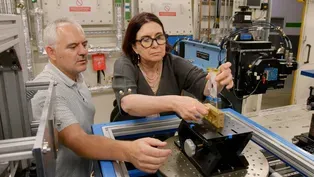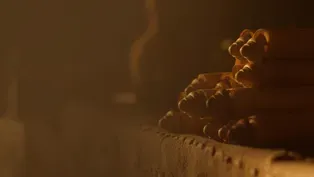
How Technology Revived Seneca the Elder
Clip: Season 21 Episode 6 | 2m 53sVideo has Closed Captions
Researcher Valeria Piano discovers long-lost history of Rome written by Seneca the Elder.
Researcher Valeria Piano employs two different technological methods to decipher a carbonized scroll from Herculaneum. First, she uses a microscope to examine the texts, and then she studies images of the scrolls produced with infrared light. Her work has brought to light a history of Rome written by Seneca the Elder, long thought to have been lost forever.
Problems with Closed Captions? Closed Captioning Feedback
Problems with Closed Captions? Closed Captioning Feedback
SECRETS OF THE DEAD is made possible, in part, by public television viewers.

How Technology Revived Seneca the Elder
Clip: Season 21 Episode 6 | 2m 53sVideo has Closed Captions
Researcher Valeria Piano employs two different technological methods to decipher a carbonized scroll from Herculaneum. First, she uses a microscope to examine the texts, and then she studies images of the scrolls produced with infrared light. Her work has brought to light a history of Rome written by Seneca the Elder, long thought to have been lost forever.
Problems with Closed Captions? Closed Captioning Feedback
How to Watch Secrets of the Dead
Secrets of the Dead is available to stream on pbs.org and the free PBS App, available on iPhone, Apple TV, Android TV, Android smartphones, Amazon Fire TV, Amazon Fire Tablet, Roku, Samsung Smart TV, and Vizio.
Buy Now

Providing Support for PBS.org
Learn Moreabout PBS online sponsorshipValeria Piano is a researcher in classical philosoph at the University of Florence.
A few years ago, she was studying fragments from one particular Herculaneum scroll at the National Library of Naples, trying to identify its author.
But much of the writing was so faded and damaged, it wasn't visible.
Even if they are unrolled, some parts of them couldn't be read.
So, technology is essential.
In order to read a carbonized papyrus, you have to usually join two kinds of methodologies: The first essential one is to directly read it by using a microscope and using the right angle of visible light.
And then, the second crucial methodology is studying the digital images that are produced usually by infrared spectrum.
The Latin scroll Valeria studied had previously been logged as a record of a political speech.
But after meticulously studying the text, she spotted a key phrase that convinced her this was actually an important lost book.
The sentence was [Speaking Latin] - “from the beginning of the Civil War.” For Valeria, this short phrase had huge significance.
The Roman philosopher Seneca the Younger, in his own works, had used this exact sentence to refer to a history of the Roman Civil War, composed by his father, Seneca the Elder.
We best know Seneca the Elder as a historian, he wrote a history of his own time, from the time of the civil wars.
Certainly, he was also interested in cataloging the political events that were taking place in Rome.
Scholars believed that Seneca the Elders history of Rome had long been lost forever.
But Valeria now thought tha the fragments she was looking at could contain writings from this missing work.
All she needed was proof.
And then, at the very end of the text, she found what she was looking for.
His name, Seneca the Elder, is partially readable at the very end of the papyrus.
I was, like, shaking.
That was really an, an unforgettable moment for, for me.
Decoding the Herculaneum Scrolls: AI Meets Ancient Texts
Video has Closed Captions
Artificial intelligence is used to find out what some carbonized Herculaneum scrolls say. (3m 34s)
Preview | The Herculaneum Scrolls
Video has Closed Captions
Scientists attempt to read ancient scrolls carbonized by the eruption of Mt. Vesuvius. (31s)
Providing Support for PBS.org
Learn Moreabout PBS online sponsorshipSupport for PBS provided by:
SECRETS OF THE DEAD is made possible, in part, by public television viewers.













